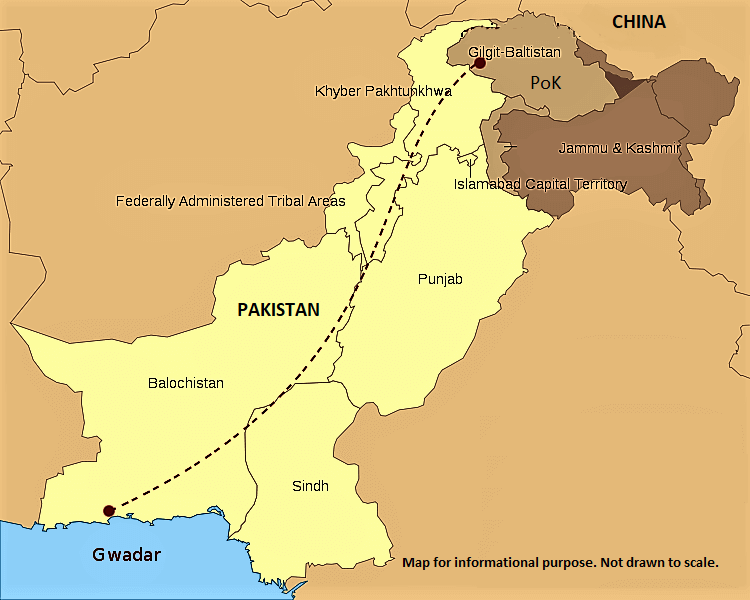The China-Pakistan Economic Corridor (CPEC) is a big project that aims to make trade between China and Pakistan easier. It’s like building a superhighway between the two countries but for goods and services instead of cars. This project is part of a bigger plan called the Belt and Road Initiative (BRI) started by China in 2013 to improve connections between countries in Eurasia.

CPEC started on April 20, 2015, when leaders from China and Pakistan signed many agreements worth a whopping $46 billion. The main goal of CPEC is to upgrade Pakistan’s roads, railways, airports, and energy systems. It also aims to link two important Pakistani ports, Gwadar and Karachi, to China’s Xinjiang region. This connection will make it faster and cheaper to transport things between China and Pakistan, bypassing long sea routes.
One exciting part of CPEC is the creation of special economic zones (SEZs), which are areas where businesses get special incentives to invest. These zones are meant to boost Pakistan’s economy quickly. Additionally, Pakistan and China are working together on space and satellite projects, thanks to CPEC.
So far, CPEC has achieved some successes, especially in building new infrastructure like highways, railways, and power plants. For instance, Pakistan got its first solar power plant in 2015, and a modern metro train system started running in Lahore in 2020, thanks to CPEC.
However, CPEC also brought some challenges. By the late 2010s, Pakistan found itself heavily in debt to China because of this project. The COVID-19 pandemic slowed down CPEC progress even more, making Pakistan’s economic problems worse. Despite creating jobs, CPEC hasn’t fully delivered on its promises to boost Pakistan’s industries and exports. Plus, the costs of fossil fuels and fixing old power systems have led to continued power shortages in the country.
Furthermore, some areas, especially Balochistan province, faced violence from local militants who opposed CPEC projects in their region.
Recent news even reported a tragic incident where five Chinese nationals and their local driver were killed in a suicide attack in Pakistan, showing the security risks involved in such projects.
Overall, while CPEC has brought some benefits, it also highlights the challenges and complexities involved in large-scale international projects like this one.
______________________________
The China-Pakistan Economic Corridor (CPEC) is a significant project aimed at enhancing infrastructure in Pakistan to facilitate better trade with China and to strengthen ties among South Asian countries. This initiative is part of a broader strategy known as the Belt and Road Initiative (BRI), initiated by China in 2013. The BRI seeks to improve connectivity, trade, communication, and cooperation across Eurasia.
CPEC was officially launched on April 20, 2015, through the signing of 51 agreements and memorandums of understanding between Chinese President Xi Jinping and Pakistani Prime Minister Nawaz Sharif. The total worth of these agreements amounted to a staggering $46 billion. The primary objective of CPEC is twofold: first, to revamp Pakistan’s economy by modernizing its transportation and energy infrastructure, including roads, railways, airports, and energy systems. Second, it aims to establish overland routes connecting the deep-sea ports of Gwadar and Karachi in Pakistan to China’s Xinjiang Uygur Autonomous Region.
Xinjiang borders several countries, including Mongolia, Russia, Kazakhstan, Kyrgyzstan, Tajikistan, Afghanistan, Pakistan, and India. Historically, this region played a vital role in trade as part of the ancient Silk Road. By linking Gwadar and Karachi to Xinjiang, CPEC seeks to reduce the time and costs associated with transporting goods and energy resources, such as natural gas, to China. This circumvents the need to navigate through the congested and sometimes politically tense Strait of Malacca and the South China Sea.
In addition to infrastructure improvements, CPEC includes plans to establish special economic zones (SEZs) modeled after successful zones in China. These SEZs offer incentives for investment and are designed to stimulate rapid economic growth within Pakistan. Furthermore, the initiative has spurred collaborations in space and satellite technology between Pakistan and China, with joint projects announced in 2016.
Overall, CPEC represents a comprehensive effort to not only enhance trade between China and Pakistan but also to foster economic development and connectivity across the wider South Asian region.
By the late 2010s, Pakistan had seen significant progress in its infrastructure thanks to the China-Pakistan Economic Corridor (CPEC). This included the completion of hundreds of miles of highways and railways, which improved transportation networks across the country. Additionally, Pakistan experienced a notable increase in its capacity for generating electricity. Although renewable energy sources only contributed a small portion to this increase, the inauguration of Pakistan’s first solar power plant in May 2015 marked a step towards diversifying the country’s energy mix.
One standout urban project resulting from CPEC was the Orange Line Metro Train system in Lahore, which commenced operations in October 2020. It was celebrated as a milestone for Pakistan’s transportation infrastructure and represented a significant step forward in public transportation within the country.
However, despite these achievements, the CPEC initiatives posed challenges for Pakistan’s economy. By the fifth year of the program, Pakistan found itself grappling with a substantial debt owed to China, comprising over one-fourth of its total debt burden. This strained Pakistan’s ability to manage its external payments and contributed to its economic woes.
Moreover, the global COVID-19 pandemic further complicated matters, causing delays in CPEC projects and exacerbating Pakistan’s economic crisis. China’s reluctance to provide debt relief amid the pandemic added to Pakistan’s financial strain.
While CPEC did create employment opportunities in Pakistan, its promises to bolster the country’s industrial sector and increase exports remained largely unfulfilled into the early 2020s. Additionally, despite expansions in energy infrastructure, Pakistan continued to face challenges with power shortages and grid failures, partly due to reliance on fossil fuels and the need for modernizing its aging power grid.
Furthermore, certain regions, particularly Balochistan province, experienced setbacks in construction due to violence from local militants opposed to CPEC projects in their area. This highlights the security risks associated with large-scale infrastructure initiatives in volatile regions.
In summary, while CPEC brought notable improvements to Pakistan’s infrastructure, it also exposed the country to economic challenges and security risks. Balancing the benefits and drawbacks of such initiatives remains a complex task for Pakistan as it navigates its economic development path.
Why did Pakistan Stop Trade with Bharat?
Pakistan’s decision to halt trade with India, often referred to as Bharat in Hindi, is rooted in longstanding political tensions and conflicts between the two neighboring countries. Several key factors have contributed to this decision:
- Diplomatic Strain: Pakistan and India have a history of strained diplomatic relations, primarily due to territorial disputes, particularly over the region of Kashmir. The dispute over Kashmir has led to multiple conflicts and wars between the two countries since their independence from British rule in 1947. These tensions have often spilled over into trade relations.
- Security Concerns: Security concerns play a significant role in Pakistan’s decision to stop trade with India. Both countries have accused each other of supporting terrorist activities on their respective soils. This has led to periodic escalations in tensions, including military standoffs and cross-border skirmishes. Pakistan’s government may perceive trade with India as potentially providing economic benefits to a country it considers a security threat.
- Political Factors: Domestic politics also influence Pakistan’s stance on trade with India. Politicians and political parties in Pakistan often leverage anti-India sentiments to bolster their popularity and legitimacy. Taking a tough stance against India, including halting trade, can be a way for Pakistani leaders to appeal to nationalist sentiments within the country.
- Kashmir Issue: The status of Kashmir remains a deeply contentious issue between Pakistan and India. Pakistan views itself as a supporter of the Kashmiri people’s right to self-determination and has consistently advocated for a resolution to the Kashmir conflict in line with UN resolutions. India’s decision to revoke the special status of Jammu and Kashmir in August 2019 further escalated tensions between the two countries and may have influenced Pakistan’s trade policies towards India.
- Regional Geopolitics: Geopolitical dynamics in the broader South Asian region also play a role in shaping Pakistan’s trade policies towards India. Both countries are vying for influence in the region, and their relations with other neighboring countries, such as Afghanistan, Bangladesh, and Nepal, often intersect with their bilateral relationship. Pakistan’s decision to halt trade with India may be influenced by its broader geopolitical calculations and alliances.
In summary, Pakistan’s decision to stop trade with India is multifaceted, stemming from a combination of historical animosities, security concerns, political considerations, and regional geopolitics. Until significant progress is made in addressing the underlying issues driving tensions between the two countries, trade relations are likely to remain strained.
Why Pakistan Gives Importance to CPEC?
Pakistan attaches significant importance to the China-Pakistan Economic Corridor (CPEC) for several reasons:
- Economic Development: CPEC is viewed as a catalyst for economic growth and development in Pakistan. The infrastructure projects under CPEC, such as highways, railways, ports, and energy plants, are expected to create jobs, stimulate economic activity, and attract foreign investment. This is particularly crucial for Pakistan, which faces challenges related to unemployment, poverty, and economic stability.
- Trade Connectivity: CPEC enhances Pakistan’s connectivity to China and other countries in the region. By linking Pakistani ports, such as Gwadar and Karachi, to China’s Xinjiang region and beyond, CPEC offers a shorter and more efficient route for trade. This can boost Pakistan’s exports, facilitate imports, and reduce transportation costs, thereby improving the country’s trade competitiveness.
- Energy Security: CPEC includes energy projects aimed at addressing Pakistan’s energy shortfall. The construction of power plants, particularly those utilizing coal, hydro, and renewable energy sources, helps to increase Pakistan’s energy generation capacity. This is crucial for overcoming frequent power shortages and ensuring a stable energy supply for industrial and domestic consumers.
- Strategic Partnership with China: CPEC strengthens Pakistan’s strategic partnership with China, one of its closest allies. The initiative reflects China’s commitment to supporting Pakistan’s development goals and enhancing bilateral cooperation in various sectors. This partnership not only contributes to Pakistan’s economic growth but also reinforces its geopolitical position in the region.
- Regional Integration: CPEC promotes regional integration by connecting Pakistan with neighboring countries and fostering economic cooperation within South Asia and beyond. Through the development of transport infrastructure and the establishment of special economic zones (SEZs), CPEC facilitates trade and investment flows, thereby contributing to regional stability and prosperity.
- Geostrategic Considerations: Pakistan views CPEC as a means to counterbalance India’s influence in the region. By strengthening its economic ties with China, Pakistan aims to enhance its strategic leverage and reduce its dependence on traditional Western partners. CPEC also aligns with Pakistan’s broader foreign policy objectives, including its efforts to diversify diplomatic and economic engagements.
Overall, CPEC is seen as a transformative initiative that holds the potential to address Pakistan’s economic challenges, strengthen its strategic ties with China, and promote regional cooperation and integration
How Must Debt on Pakistan Due to CPEC?
The debt burden on Pakistan due to the China-Pakistan Economic Corridor (CPEC) has been a subject of scrutiny and concern. The exact amount of debt directly attributed to CPEC is not always clear-cut, as it involves various financial arrangements, loans, and infrastructure projects with Chinese involvement. However, several factors contribute to Pakistan’s indebtedness related to CPEC:
- Infrastructure Loans: China has provided significant loans to finance various infrastructure projects under CPEC, including roads, railways, ports, and energy projects. These loans often come with favorable terms, but they still add to Pakistan’s overall debt burden, especially considering the scale of investment involved.
- Special Economic Zones (SEZs): The establishment of Special Economic Zones (SEZs) under CPEC requires substantial investment in infrastructure and incentives to attract foreign investment. While these zones are intended to stimulate economic growth and create employment opportunities, the initial investment may contribute to Pakistan’s debt if financed through loans or other forms of borrowing.
- Energy Projects: Pakistan has undertaken several energy projects as part of CPEC to address its power shortages. While these projects are essential for meeting the country’s energy needs, the financing arrangements, which often involve loans from Chinese banks or companies, contribute to Pakistan’s debt burden.
- Repayment Obligations: Pakistan is obligated to repay the loans obtained for CPEC projects, including both the principal amount and any accrued interest. Meeting these repayment obligations adds to Pakistan’s financial strain, particularly if the returns on investment from CPEC projects do not meet expectations or if economic conditions deteriorate.
- Currency Fluctuations: Fluctuations in currency exchange rates can also impact Pakistan’s debt burden related to CPEC, especially if the loans are denominated in foreign currencies such as the Chinese yuan. Depreciation of the Pakistani rupee against the borrowing currency can increase the cost of servicing the debt.
Overall, while CPEC brings potential economic benefits to Pakistan in terms of infrastructure development, energy security, and trade facilitation, the associated debt raises concerns about the country’s fiscal sustainability and long-term financial viability. Managing and mitigating the debt incurred from CPEC projects is essential to ensure that the initiative contributes positively to Pakistan’s economic growth and development in the long run
What factors have led to China ceasing aid to Pakistan and exerting pressure for the repayment of debts extended to Pakistan?
Several factors have contributed to China discontinuing aid to Pakistan and exerting pressure for the repayment of debts extended to Pakistan:
- Economic Constraints: China faces its own economic challenges and constraints. With increasing domestic priorities and economic pressures, China may need to redirect its resources away from providing aid and loans to other countries, including Pakistan. Economic considerations, such as budget constraints and debt sustainability concerns, may prompt China to reassess its financial assistance to Pakistan.
- Debt Sustainability Concerns: Pakistan’s growing debt burden, including debts owed to China for infrastructure projects under the China-Pakistan Economic Corridor (CPEC), has raised concerns about debt sustainability. China may be pressuring Pakistan to prioritize debt repayment to ensure the financial viability of CPEC projects and mitigate risks associated with Pakistan’s rising debt levels.
- Transparency and Accountability: There have been criticisms regarding the transparency and accountability of CPEC projects and the terms of loans provided by China to Pakistan. Concerns about corruption, lack of transparency in project contracts, and the terms of Chinese loans have led to calls for greater scrutiny and accountability. China may be exerting pressure on Pakistan to address these governance issues and ensure the proper use of funds allocated for CPEC projects.
- Geopolitical Considerations: China’s foreign policy objectives and geopolitical interests also play a role in its relationship with Pakistan. While China values its strategic partnership with Pakistan, it may seek to balance its relationships with other countries in the region, including India. Changes in geopolitical dynamics or shifts in China’s strategic priorities may influence its decisions regarding aid and financial assistance to Pakistan.
- Project Delays and Performance: Delays and performance issues in CPEC projects may have led to concerns about the effectiveness and viability of investments made by China in Pakistan. China may be pressuring Pakistan to expedite project implementation, improve project management, and ensure the successful completion and operation of CPEC infrastructure projects to protect its investments and achieve desired outcomes.
Overall, a combination of economic, financial, governance, geopolitical, and project-related factors has led to China ceasing aid to Pakistan and exerting pressure for the repayment of debts extended to Pakistan. Addressing these challenges will require close cooperation and dialogue between China and Pakistan to ensure the long-term sustainability and success of their bilateral relationship and CPEC initiatives
25 Points to be Noted About CPEC
- Scale: The China-Pakistan Economic Corridor (CPEC) is a massive infrastructure and economic development project.
- Bilateral Agreement: CPEC is a bilateral agreement between China and Pakistan, signed in 2015.
- Investment: China pledged billions of dollars in investment for CPEC projects.
- Belt and Road Initiative (BRI): CPEC is a flagship project of China’s BRI, aimed at enhancing connectivity and trade.
- Strategic Location: CPEC connects China’s Xinjiang region with Pakistan’s Gwadar Port, providing China access to the Indian Ocean.
- Infrastructure Development: CPEC involves the construction of roads, railways, ports, and energy projects in Pakistan.
- Energy Projects: CPEC includes energy projects to address Pakistan’s power shortages.
- Special Economic Zones (SEZs): SEZs are being established under CPEC to promote industrial development and attract foreign investment.
- Gwadar Port: CPEC aims to develop Gwadar Port into a major trade hub, facilitating maritime trade.
- Economic Growth: CPEC is expected to boost Pakistan’s economic growth and create employment opportunities.
- Connectivity: CPEC enhances connectivity within Pakistan and with China, Central Asia, and beyond.
- Challenges: CPEC faces challenges such as security concerns, financing issues, and environmental impacts.
- Debt Concerns: Pakistan’s increasing debt burden due to CPEC projects has raised concerns about debt sustainability.
- Governance Issues: Transparency and governance issues have been raised regarding CPEC project contracts and financing terms.
- Regional Impact: CPEC has implications for regional geopolitics and economic dynamics, including relations with India.
- Socioeconomic Development: CPEC aims to promote socioeconomic development in underdeveloped regions of Pakistan.
- Industrial Cooperation: CPEC promotes industrial cooperation between China and Pakistan through joint ventures and technology transfer.
- Cultural Exchange: CPEC fosters cultural exchange and people-to-people ties between China and Pakistan.
- Environmental Concerns: CPEC projects raise environmental concerns, including deforestation and pollution.
- Job Creation: CPEC projects create job opportunities in construction, manufacturing, and other sectors.
- Security: Security measures are essential to protect CPEC infrastructure and personnel from threats.
- Public Perception: Public opinion about CPEC varies, with some seeing it as a driver of development and others expressing skepticism about its benefits.
- International Partnerships: CPEC may lead to partnerships with other countries interested in participating in BRI projects.
- Long-Term Vision: CPEC is part of a long-term vision for China-Pakistan cooperation and regional integration.
- Future Prospects: The success of CPEC depends on effective implementation, addressing challenges, and maximizing benefits for both China and Pakistan.



